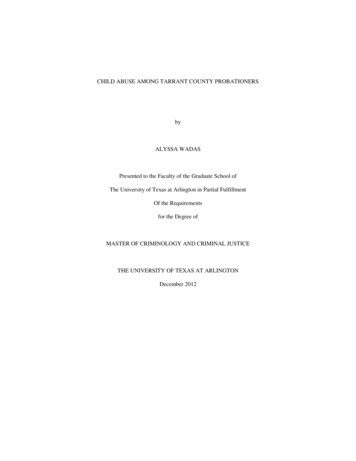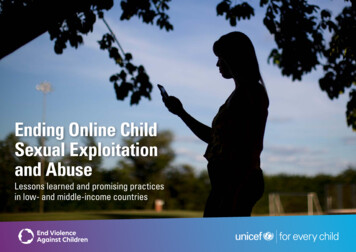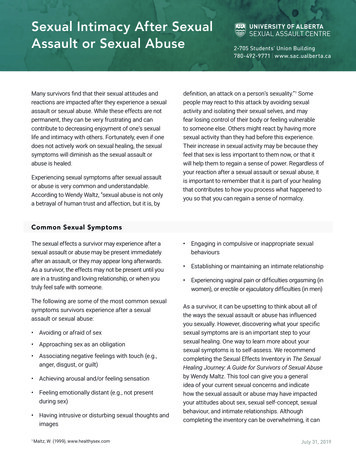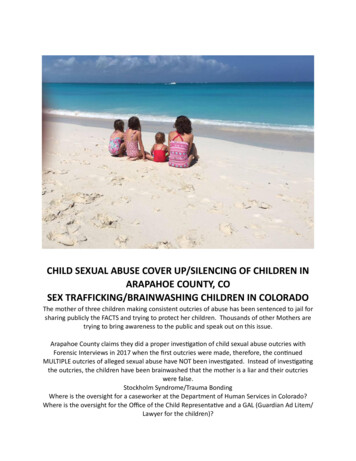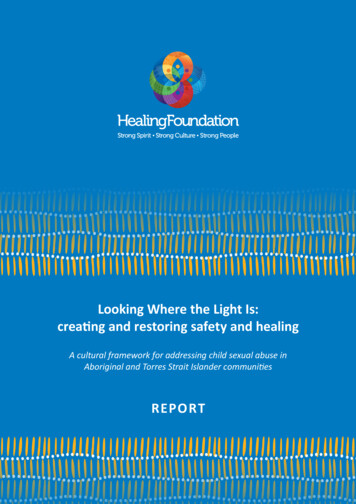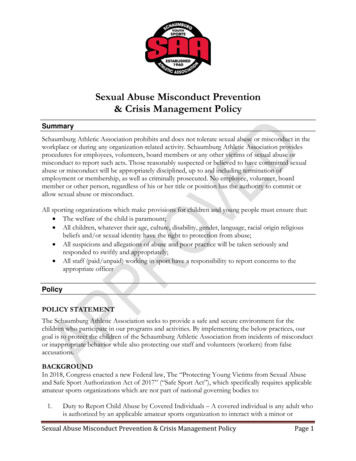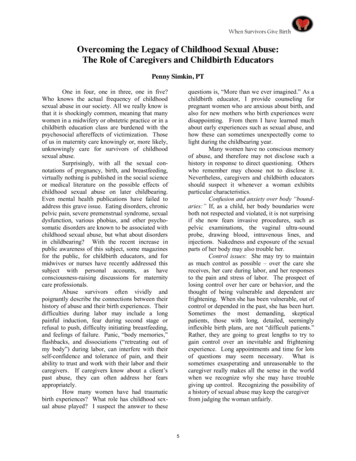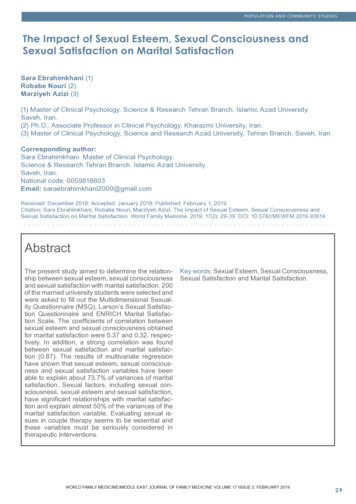
Transcription
PreventingChild Sexual Abuse WithinYouth-serving Organizations:Getting Started on Policiesand ProceduresFor more information:CS107800Centers for Disease Control and PreventionNational Center for Injury Prevention and Control1-800-CDC-INFO www.cdc.gov/injury CDCinfo@cdc.govU.S. DEPARTMENT OF HEALTH AND HUMAN SERVICESCenters for Disease Control and Prevention
Preventing Child Sexual AbuseWithin Youth-serving Organizations:Getting Started on Policiesand ProceduresU.S. DEPARTMENT OF HEALTH AND HUMAN SERVICESCenters for Disease Control and PreventionNational Center for Injury Prevention and ControlDivision of Violence PreventionAtlanta, Georgia2007
Preventing Child Sexual Abuse Within Youth-serving Organizations: Getting Started on Policies andProcedures is a publication of the National Center for Injury Prevention and Control of the Centers for Disease Control and Prevention.Centers for Disease Control and PreventionJulie L. Gerberding, M.D., M.P.H., DirectorCoordinating Center for Environmental Health and Injury PreventionHenry Falk, M.D., M.P.H., DirectorNational Center for Injury Prevention and ControlIleana Arias, Ph.D., DirectorDivision of Violence PreventionW. Rodney Hammond, Ph.D., DirectorSuggested citation: Saul J, Audage NC. Preventing Child Sexual Abuse Within Youth-serving Organizations:Getting Started on Policies and Procedures. Atlanta (GA): Centers for Disease Control and Prevention,National Center for Injury Prevention and Control; 2007.ii
AuthorsJanet Saul, Ph.D.Division of Violence PreventionNational Center for Injury Prevention and ControlNatalie C. Audage, M.P.H.Consultant and former ASPH/CDC FellowAcknowledgementsThe authors would like to acknowledge the individuals and organizations that participated in themeeting of experts sponsored by CDC in August 2004. The authors would also like to thankKristin Leydig Bryant for facilitating the meeting and Deborah A. Ausburn, Attorney at Law,for reviewing the document.iii
Table of ContentsIntroduction.1Components of Child Sexual Abuse Prevention .3Screening and selecting employees and volunteers.4Guidelines on interactions between individuals.9Monitoring behavior.13Ensuring safe environments.15Responding to inappropriate behavior, breaches in policy, and allegationsand suspicions of child sexual abuse.17Training about child sexual abuse prevention.22Training employees/volunteers.24Training caregivers.27Training youth.28Overcoming Challenges to Child Sexual Abuse Prevention inYouth-serving Organizations.29Conclusion: Moving Forward.33Organizational processes for developing and implementing child sexual abuseprevention policies.33Child sexual abuse prevention planning tool for organizations.35AppendixesAppendix A: Participant List.39Appendix B: Resource List and Sample ournal articles.47Sample policies from participating organizations.47Publications with sample policies and procedures.48Relevant organizations.49iv
IntroductionYouth-serving organizations strive to create a safe environment for youth,employees, and volunteers so that youth can grow, learn, and have fun. Part ofcreating a safe environment is making sure that youth are not harmed in any waywhile participating in organization-sponsored activities. One risk in any organizationworking directly with youth is child sexual abuse.It is vital that organizations create a culture where child sexual abuse is discussed,addressed, and prevented.This report is designed for representatives of youth-serving organizations whoare interested in adopting strategies to prevent child sexual abuse. Whether thesestrategies are developed within the context of an overall risk management planor are addressed separately, organizations need to examine how they can protectyouth from sexual abuse.Definitions Children and youth- Anyone between the ages of zero and 17 years. In this document,these terms are used interchangeably. Child sexual abuse- “Child sexual abuse involves any sexual activity with a child where consent is not or cannot be given. This includes sexual contact that is accomplished by force or threat of force,regardless of the age of the participants, and all sexual contact between an adult and achild, regardless of whether there is deception or the child understands the sexual natureof the activity. Sexual contact between an older and a younger child also can be abusive ifthere is a significant disparity in age, development, or size, rendering the younger childincapable of giving informed consent. The sexually abusive acts may include sexualpenetration, sexual touching, or non-contact sexual acts such as exposure or voyeurism.”1-Legal definitions vary by state, so look up your state guidelines using the Child WelfareInformation Gateway (www.childwelfare.gov/systemwide/laws policies/search/index.cfm).What You Will Find in This ReportIn the first section, you will find six key components of child sexual abuse prevention for organizations. These components were identified by the Centers for Disease Control and Prevention(CDC) in conjunction with experts:1.2.3.4.5.Screening and selecting employees and volunteersGuidelines on interactions between individualsMonitoring behaviorEnsuring safe environmentsResponding to inappropriate behavior, breaches in policy, and allegations and suspicions ofchild sexual abuse6. Training about child sexual abuse prevention.Myers JEB, Berliner L, Briere J, Hendrix CT, Jenny C, Reid TA, editors. The APSAC handbook of child maltreatment.2nd ed. Thousand Oaks (CA): Sage Publications; 2002. p. 55.1
Each component is described in detail, including the prevention goals, critical strategies, and additional strategies that could be considered depending on the context and resources of individualorganizations.The sections that follow offer suggestions for addressing challenges to developing and implementing a strategy to prevent child sexual abuse and provide tools to help organizations move forward.A list of publications and organizations that can provide helpful information is provided inAppendix B.Contextual IssuesEvery organization does not have to take on all strategies presented in this document. The processof implementing child sexual abuse prevention strategies takes time and will evolve differently ineach organization. Not all strategies presented in this document will apply to all organizations.However, it is very important that organizations abide by their youth protection policies and procedures to avoid being criticized for not adhering to them if a youth is sexually abused. Adoptionof strategies will depend on the following contextual issues: Organization’s mission and individual activities. For example, though all youth-servingorganizations are interested in helping youth develop into healthy adults, the mission ofmentoring or religious organizations is often focused on fostering nurturing relationshipsbetween individual adults and youth. Because this mission results in more one-on-oneactivities between employees/volunteers and youth, these organizations need to adopt childsexual abuse prevention strategies that protect youth in one-on-one situations with adults. Culture and language of youth served by the organization. Insurance requirements. Available resources. State and national laws. Organizations should consult with legal representation and reviewstate and national laws before adopting and implementing child sexual abuse preventionstrategies. A good place to start is the Child Welfare Information Gateway, which providesstate-specific information (www.childwelfare.gov/systemwide/laws policies/search/index.cfm).Balancing Caution and CaringThe same dynamics that create a nurturing environment, and may ultimately protect against childsexual abuse, can also open the doors to sexually abusive behaviors. Research has shown that youthwho are emotionally insecure, needy, and unsupported may be more vulnerable to the attentions ofoffenders.2 By promoting close and caring relationships between youth and adults, organizationscan help youth feel supported and loved and thus reduce their risk of child sexual abuse. But thatsame closeness between a youth and an adult can also provide the opportunity for abuse to occur.When developing policies for child sexual abuse prevention, organizations must balance the needto keep youth safe with the need to nurture and care for them.Finkelhor D. Four preconditions: a model. In: Finkelhor D, editor. Child sexual abuse: new theory and research.New York (NY ): The Free Press; 1984. p. 53–68.2
Components of Child Sexual AbusePreventionThe components that follow were identified duringa meeting of experts sponsored by CDC in August2004. The experts included advocates, child sexualabuse researchers, professionals who provide prevention resources for organizations, and representativesof youth-serving organizations that have child sexualabuse prevention programs. For a list of meetingparticipants, see Appendix A.
Component 1:Screening and Selecting Employees and VolunteersGoalTo select the best possible people for staff and volunteer positions and to screen out individualswho have sexually abused youth or are at risk to abuse.General PrinciplesScreening for child sexual abuse prevention should be integrated into the general screening andselection process that organizations already employ to choose the best possible candidates for positions. Child sexual abuse prevention should be one of the many areas considered when decidingwhom to select. While employee/volunteer screening and selection are important, they should notbe the only efforts adopted to prevent child sexual abuse.Before you start screening Develop criteria that define how screening information will be used to determine an applicant’s suitability.Identify who will make the final selection.Define areas of concern such as a fixation on a particular age or gender of youth or a historyof crimes related to sex or violence.Develop consistent and systematic policies and processes for screening and selection, including a sequence and timeline for the various components of the process.Consult with an attorney to ensure that your screening and selection policies do not violateTitle VII of the Civil Rights Act or other federal or state laws prohibiting discrimination inthe workplace.Who should be screened? Screen all applicants, both adults and adolescents, for all positions that will have contactwith youth.Consider more in-depth written applications and personal interviews for adolescents, forwhom work history and criminal background checks may be unavailable.Rigorously screen applicants who will have more autonomy as employees or volunteers.Do not make exceptions for people you know or have worked with in the past.Critical Strategies for Screening and Selecting Employees and Volunteers(These strategies are presented in roughly the order that they should be completed.)Education about your organization and youth-protection policiesBy letting applicants know your organization is serious about protecting youth, you may detersome people at risk of abusing youth from applying for staff or volunteer positions. Inform applicants about your organization’s policies and procedures relevant to child sexualabuse prevention. Share your code of conduct or ethics. Require applicants to sign a document describing the policies and procedures of your organization to demonstrate their understanding and agreement. Ask applicants if they have a problem with any of the policies and procedures.
Written applicationThe written application provides the information you need to assess the background and interests of applicants. Questions should help you determine whether applicants have mature, adultrelationships as well as clear boundaries and ethical standards for their conduct with youth. Thesidebar on page 6 may help you develop appropriate questions. Ask about previous work and volunteer experiences. Ask questions pertinent to child sexual abuse screening. Provide a permission form for contacting personal references and performing a criminalbackground check. The permission statement should include an indemnification clausedeveloped by an attorney to protect your organization from false allegations or other legalissues. Ask open-ended questions that encourage broad answers. These will provide material forfollow-up in the personal interview and throughout the screening and selection process. Use disclosure statements to ask applicants about previous criminal histories of sexual offenses, violence against youth, and other criminal offenses. The applicant may not disclosepast offenses, but the inquiry will demonstrate your organization’s seriousness about protecting youth and potentially discourage applicants at risk for perpetrating child sexual abuse. Clarify that you are interested in learning about an applicant’s past perpetration of childsexual abuse rather than a history of victimization.Personal interviewThe personal interview provides an opportunity tomeet applicants, determine if they are a good fit foryour organization, and ask additional questions toscreen for child sexual abuse risk factors. The sidebaron page 6 may help you develop interview questions. Ask open-ended questions that encouragediscussion. Clarify and expand upon the applicant’sanswers to questions from the writtenapplication.
Questions for Screening and Selecting Employees and VolunteersThe following questions may be used in a written application or personal interview. Asingle answer should not determine whether an applicant is selected or rejected. Alongwith other forms of information, answers to these questions can help you build a morecomplete picture of an applicant. Additional questions may be found in various publications and policies in the “Resource List and Sample Policies” section. (See Appendix B.) What type of supervisory situation do you prefer?If applicants are very independent, they may not fit in an organization whosepolicies and procedures require close supervision. What age/sex of youth do you want to work with? How would you feel aboutworking with a different age/sex?If an applicant seems fixated on one age/sex, be wary. However, it may be thatthe applicant has experience or is gifted with working with certain age groups.Asking follow-up questions about why an applicant has a strong preference canhelp you determine if there is cause for concern. Is there anyone who might suggest that you should not work with youth? Whyor why not? Why do you want the job? What would you do in a particular situation?Set up scenarios that involve potential concerns, boundary issues, or youth protection policies and interactions to gauge the applicant’s response. Be concernedif applicants disregard the organization’s policies and procedures or handle asituation poorly. What makes you a good candidate for working with youth? What would yourfriends or colleagues say about how you interact with youth? What other hobbies or activities do you enjoy?Determine if applicants have mature, adult relationships—not just relationshipswith youth.
Reference checksReference checks provide additional information about applicantsand help verify previous work and volunteer history. Obtain verbal—not just written—references for applicants. Conversations can elicit much more informationthan written responses. Match references with employment and volunteer history.Is anyone important missing from the references, suchas the supervisor from the applicant’s most recent job?To provide a more complete picture of the applicant, thereferences should come from a variety of sources andshould not be limited to family members or friends. Be aware that many employers will only provide basicinformation, such as dates of employment or rehiringeligibility. If a former employer will only providelimited information, clarify whether the personproviding the reference is limiting informationbecause of company policy.The following questions may be useful for reference checks: How would you describe the personal characteristics of the applicant? How does the applicant interact with youth? Why would this person be a good candidate for working with youth? Is there any reasonthis person should not work with youth? Have you seen the applicant discipline youth (other than his or her own children)? Would you hire this person again? Would you want him or her in your organization in thefuture?Criminal background checksCriminal background checks are an important tool in screening and selection. However, theyhave limitations. Criminal background checks will not identify most sexual offenders becausemost have not been caught. When this report was published, an efficient, effective, and affordablenational background screening system was not available. Use background checks as one part of child sexual abuse prevention efforts. Using background checks alone may give your organization a false sense of security. Save time and resources by delaying criminal background checks until the end of the screening and selection process. Applicants who do not make it through the written applications,personal interviews, and reference checks will not need a criminal background check. Obtain permission from applicants before beginning a criminal background check. Determine the type and level of check required for each applicant. Types of checks includename, fingerprint, sex offender registries, and social security number. Checks may be implemented at county, state, and national levels. Records are not always linked or comprehensive,so a thorough search may be needed to address concerns about an applicant. For example, ifan applicant has moved frequently, checks in multiple states may be necessary. Plan for the time and financial resources needed to conduct background checks. Decide which offenses to examine in the background checks and which offenses will disqualify applicants. For child sexual abuse, absolute disqualifiers include violent behavior and
child sexual abuse perpetration history. Depending on the risk of the situation or the mission of your organization, drug and driving offenses may also be disqualifiers. Arrest data arenot grounds for disqualification; only offenses resulting in convictions may be used.Develop procedures to keep the results of criminal background checks confidential. Select asecure storage location and limit access to the files.Ensure that your organization’s process for conducting criminal background checks is legallysound. Consult county, state, and national laws and regulations, as well as your organization’s attorney and insurance company, as needed.Additional Strategies to ConsiderAssessment of home environmentThe need for assessing an applicant’s home environment depends on the mission of your organization. This may be an essential strategy for mentoring programs where youth meet with mentors attheir homes, but it may be irrelevant and inappropriate for other organizations, such as sleep-awaycamps or after-school programs.Checking applicants against internal recordsThis strategy involves keeping lists of applicants who are disqualified during the screening processand employees/volunteers who are dismissed because of an offense. During the screening and selection process, your organization would then check current applicants against these lists to makesure the applicant has not been previously disqualified or dismissed.Internet searchSome organizations may choose to search the internet to find additional relevant informationabout an applicant. Be aware that more than one person can share the same name and that it maybe difficult to verify the accuracy of information found on the internet.
Component 2:Guidelines on Interactions Between IndividualsGoalTo ensure the safety of youth in their interactions with employees/volunteers and with each other.General PrinciplesGuidelines on interactions between individuals should be determined by an organization’s missionand activities. For example, organizations that promote one-on-one activities between adults andyouth may need different interaction guidelines than programs built around group activities.Organizations should develop interaction policies before situations arise. The strategies listedbelow should be tailored to the developmental age and maturity of the youth and employees/volunteers. Strategies should also match the cultural context of the population served by the organization. In this section, “adult” refers to any individual in a supervisory position, including youth.Balancing positive and negative Find a balance between encouraging positive and appropriate interactions and discouraginginappropriate and harmful interactions.Adopt strategies with this balance in mind to ensure that youth benefit from your programwithout risk of sexual abuse or harm.Critical Strategies for Guidelines on Interactions between IndividualsAppropriate/inappropriate/harmful behaviorsAppropriate, positive interactions among youth and between employees/volunteers and youth areessential in supporting positive youth development, making youth feel valued, and providing thecaring connections that serve as protective factors for youth. Conversely, inappropriate or harmfulinteractions put youth at risk for adverse physical and emotional outcomes. Organizations shouldidentify behaviors that fall into the categories of appropriate, inappropriate, and harmful. Thesecategorizations can be spelled out in your code of conduct or ethics. Carefully balance the benefitsof appropriate interactions with the risks associated with inappropriate interactions. See page 10for examples of appropriate/innappropriate/harmful behaviors.Ratios of employees/volunteers to youthThe goal of setting ratios for the numbers of employees/volunteers to youth is to ensure the safetyof the youth. There is no standard ratio for all situations. When making decisions about ratios,consider contextual variables such as: Age and developmental level of youth and employees/volunteers. If youth or employees/volunteers are young, you may need a lower ratio, that is, fewer youth per adult. Risk of the activity. Does it involve a great deal of isolation from others? Location of the activity. Is it in a classroom that is easy to monitor or at a park, where it iseasier to lose track of individuals?Encourage employees/volunteers to actively interact with the youth to maintain adequate supervision and monitoring. Even with a satisfactory ratio of employees/volunteers to youth, the youthare not being monitored if all of the employees/volunteers are immersed in their own conversations in a corner of the room.
Examples of Appropriate/Inappropriate/Harmful Behaviorfrom Youth-serving OrganizationsSometimes it is unclear if a behavior is appropriate, inappropriate, or harmful. Forexample, intimate contact, such as kissing, may be developmentally appropriate forolder youth, but may be inappropriate within the confines of the organization. It mayeven be harmful if the kissing is coercive. Another example involves hugging. Huggingmay be appropriate and positive in some circumstances, but it can also be inappropriate if the child is not receptive, if the employee/volunteer is hugging too often or for toolong, or if the contact is romanticized or sexually intimate.Verbal communicationAppropriate: Praise Positive reinforcement for good work/behaviorInappropriate/harmful: Sexually provocative or degrading comments Risqué jokesPhysical behaviorAppropriate: Pats on the back or shoulderInappropriate/harmful: Patting the buttocks Intimate/romantic/sexual contact Corporal punishment Showing pornography or involving youth in pornographic activities10
One-on-one interactionsSome organizations have a policy to limit one-on-oneinteractions between youth and adults(i.e., having at least two adults present at all times withyouth). The goal of such a policy is to prevent theisolation of one adult and one youth, a situation thatelevates the risk for child sexual abuse. This strategymust be modified based on the mission of yourorganization. Limit one-on-one interactions whenever possible by having at least two adults present at alltimes with youth. Choose one of three options relating to thispolicy:- Make this a mandatory policy at alltimes.-Make this policy dependent on the riskof the activity or situation, such asovernight trips.-Maintain other safeguards such as extra supervision orcontact with youth and employees/volunteers and more stringent screening ifthe mission of your organization requires one-on-one time between employees/volunteers and youth (e.g., mentoring programs).Risk of interactions between youthYour organization needs to address interactions among youth in addition to monitoring interactions between employees/volunteers and youth. Many strategies that focus on the interactionsbetween employees/volunteers and youth can be tailored to address interactions among youth. Address all situations where unsupervised youth can sexually or physically abuse otheryouth. For example, if your organization has a policy that prevents adults from being present in locker rooms because of the risk of child sexual abuse, this may result in a situationwhere unsupervised youth can sexually or physically abuse other youth. A potential solutionis adopting a policy that requires more than one adult to be present at all times. Develop policies to deal with bullying and sexual abuse so that positive interactions can bepromoted while acknowledging that some interactions are inappropriate or harmful.Prohibitions and restrictions on certain activitiesSome activities, such as hazing and secret ceremonies, overnight trips, bathing, changing, bathroom interactions, and nighttime activities, pose greater risks for child sexual abuse. Prohibiting orrestricting such activities will depend largely on the context of your organization. For example, asleep-away camp would not be able to prohibit overnight trips or bathing.Out-of-program contact restrictionsThere are two types of out-of-program contact restrictions. The first type involves the contact ofyouth with employees/volunteers outside the context of the program. Your organization shouldlimit contact between employees/volunteers and youth to organization-sanctioned activities andprograms and/or to certain locations, such as activities within your organization’s building.11
The second type is contact between youth and people not affiliated with your organization thatoccurs while youth are under the care of your organization. Develop a system for monitoring the comings and goings of all youth and adults who enterand leave your facility. This system might include procedures for signing in and out. Develop specific policies about interactions between youth and people not affiliated withyour organization if it is located in a building that houses more than just your program or ifyour organization’s activities take place in public areas (e.g., sports field).Caregiver information and permissionYour organization should obtain addresses and contact information for youth and caregivers (i.e., parents and guardians). This information should neverbe released to unauthorized individuals. Your organization also should obtain permission from caregiversfor youth to participate in certain activities, such asfield trips, late-night activities, and overnight trips. Inform caregivers about what their children/youth will be doing and where they will begoing. Allow caregivers to have input on what activitiesor interactions they are comfortable with fortheir children.Responsibility for youthYour organization should clarify when it is responsible for youth and when caregivers are responsible. Develop a policy on when your organization starts and stops being responsible for youth. Consider who is responsible for youth before and after activities officially begin. Communicate the policy to caregivers and youth in writing. Organizations may also wantcaregivers to sign an acknowledgement that they have read and understand the policy.Additional St
ii Preventing Child Sexual Abuse Within Youth-serving Organizations: Getting Started on Policies and Procedures is a publication of the National Center for Injury Prevention and Control of the Cen- ters for Disease Control and Prevention.

